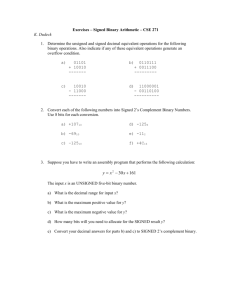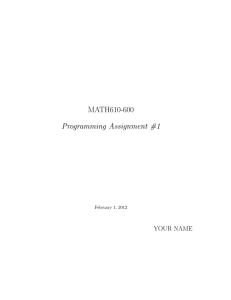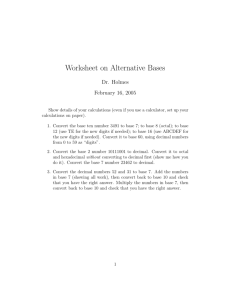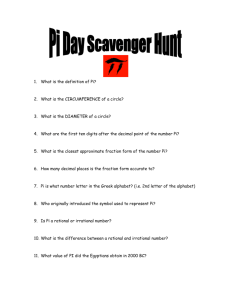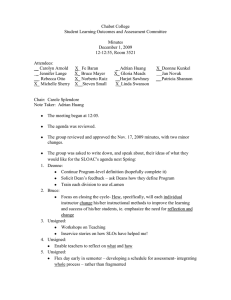MySQL Data Types - Quick Reference
advertisement
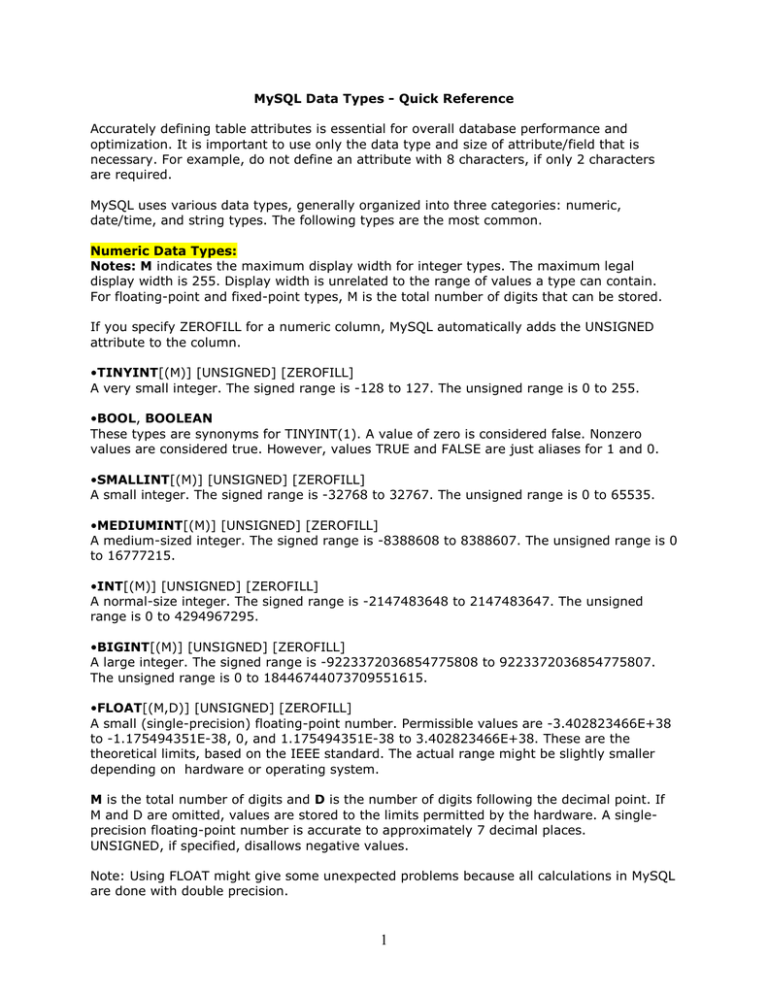
MySQL Data Types - Quick Reference
Accurately defining table attributes is essential for overall database performance and
optimization. It is important to use only the data type and size of attribute/field that is
necessary. For example, do not define an attribute with 8 characters, if only 2 characters
are required.
MySQL uses various data types, generally organized into three categories: numeric,
date/time, and string types. The following types are the most common.
Numeric Data Types:
Notes: M indicates the maximum display width for integer types. The maximum legal
display width is 255. Display width is unrelated to the range of values a type can contain.
For floating-point and fixed-point types, M is the total number of digits that can be stored.
If you specify ZEROFILL for a numeric column, MySQL automatically adds the UNSIGNED
attribute to the column.
•TINYINT[(M)] [UNSIGNED] [ZEROFILL]
A very small integer. The signed range is -128 to 127. The unsigned range is 0 to 255.
•BOOL, BOOLEAN
These types are synonyms for TINYINT(1). A value of zero is considered false. Nonzero
values are considered true. However, values TRUE and FALSE are just aliases for 1 and 0.
•SMALLINT[(M)] [UNSIGNED] [ZEROFILL]
A small integer. The signed range is -32768 to 32767. The unsigned range is 0 to 65535.
•MEDIUMINT[(M)] [UNSIGNED] [ZEROFILL]
A medium-sized integer. The signed range is -8388608 to 8388607. The unsigned range is 0
to 16777215.
•INT[(M)] [UNSIGNED] [ZEROFILL]
A normal-size integer. The signed range is -2147483648 to 2147483647. The unsigned
range is 0 to 4294967295.
•BIGINT[(M)] [UNSIGNED] [ZEROFILL]
A large integer. The signed range is -9223372036854775808 to 9223372036854775807.
The unsigned range is 0 to 18446744073709551615.
•FLOAT[(M,D)] [UNSIGNED] [ZEROFILL]
A small (single-precision) floating-point number. Permissible values are -3.402823466E+38
to -1.175494351E-38, 0, and 1.175494351E-38 to 3.402823466E+38. These are the
theoretical limits, based on the IEEE standard. The actual range might be slightly smaller
depending on hardware or operating system.
M is the total number of digits and D is the number of digits following the decimal point. If
M and D are omitted, values are stored to the limits permitted by the hardware. A singleprecision floating-point number is accurate to approximately 7 decimal places.
UNSIGNED, if specified, disallows negative values.
Note: Using FLOAT might give some unexpected problems because all calculations in MySQL
are done with double precision.
1
•DOUBLE[(M,D)] [UNSIGNED] [ZEROFILL]
A normal-size (double-precision) floating-point number. Permissible values are 1.7976931348623157E+308 to -2.2250738585072014E-308, 0, and
2.2250738585072014E-308 to 1.7976931348623157E+308. These are the theoretical
limits, based on the IEEE standard. The actual range might be slightly smaller depending on
hardware or operating system.
M is the total number of digits and D is the number of digits following the decimal point. If
M and D are omitted, values are stored to the limits permitted by the hardware. A doubleprecision floating-point number is accurate to approximately 15 decimal places.
UNSIGNED, if specified, disallows negative values.
•DECIMAL[(M[,D])] [UNSIGNED] [ZEROFILL]
An “exact” fixed-point number. M is the total number of digits (the precision) and D is the
number of digits after the decimal point (the scale). The decimal point and (for negative
numbers) the “-” sign are not counted in M. If D is 0, values have no decimal point or
fractional part. The maximum number of digits (M) for DECIMAL is 65. The maximum
number of supported decimals (D) is 30. If D is omitted, the default is 0. If M is omitted, the
default is 10.
UNSIGNED, if specified, disallows negative values.
All basic calculations (+, -, *, /) with DECIMAL columns are done with a precision of 65
digits. Use DECIMAL for currency attributes!
Date and Time Types:
•DATE
Displays DATE values in 'YYYY-MM-DD' format.
•DATETIME
A date and time combination. Displays DATETIME values in 'YYYY-MM-DD HH:MM:SS'
format.
•TIME
Displays TIME values in 'HH:MM:SS' format.
•YEAR[(2|4)]
A year in two-digit or four-digit format. The default is four-digit format. Displays YEAR
values in YYYY format.
String Types:
Most data stored will be in string format. This list describes the common MySQL string
datatypes.
MySQL interprets length specifications in character column definitions in character units.
This applies to CHAR, VARCHAR, and the TEXT types.
•CHAR[(M)]
A fixed-length string that is always right-padded with spaces to the specified length when
stored. M represents the column length in characters. The range of M is 0 to 255. If M is
omitted, the length is 1.
2
•VARCHAR(M)
A variable-length string. M represents the maximum column length in characters. The range
of M is 0 to 65,535.
MySQL stores VARCHAR values as a one-byte or two-byte length prefix plus data. The
length prefix indicates the number of bytes in the value. A VARCHAR column uses one
length byte if values require no more than 255 bytes, two length bytes if values may require
more than 255 bytes.
•TEXT[(M)]
A TEXT column with a maximum length of 65,535 characters. The effective maximum length
is less if the value contains multi-byte characters. Each TEXT value is stored using a twobyte length prefix that indicates the number of bytes in the value.
An optional length M can be given for this type. If this is done, MySQL creates the column
as the smallest TEXT type large enough to hold values M characters long.
•ENUM('value1','value2',...)
An enumeration. A string object that can have only one value, chosen from the list of values
'value1', 'value2', ..., NULL or the special '' error value. An ENUM column can have a
maximum of 65,535 distinct values. ENUM values are represented internally as integers.
References
http://dev.mysql.com/doc/refman/5.1/en/index.html
http://dev.mysql.com/doc/refman/5.0/en/data-types.html
http://dev.mysql.com/doc/refman/5.0/en/data-type-overview.html
http://dev.mysql.com/doc/refman/5.1/en/data-types.html
http://dev.mysql.com/doc/refman/5.1/en/data-type-overview.html
http://www.tutorialspoint.com/cgi-bin/printversion.cgi?tutorial=mysql&file=mysql-datatypes.htm
http://bytes.com/serversidescripting/mysql/tutorials/introductiontomysql/page1.html
http://www.w3schools.com/sql/sql_datatypes.asp
http://kimbriggs.com/computers/computer-notes/mysql-notes/mysql-data-types-50.file
http://www.tech-evangelist.com/2007/12/09/mysql-data-types/
SQL Syntax:
http://dev.mysql.com/doc/refman/5.0/en/sql-syntax.html
http://dev.mysql.com/doc/refman/5.1/en/sql-syntax.html
3
